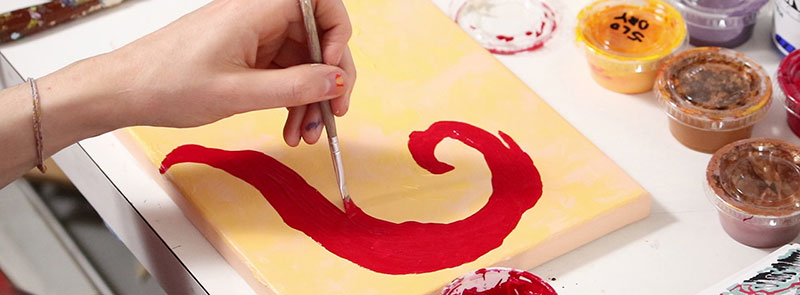Prompt
Start a painting with an underpainting, using the complementary colors of the objects in the image.
For example, in the painting below, the blue area in the underpainting was chosen because eventually the orange of the lobster will be painted over the blue.

complementary colorS
Underpaintings
- An underpainting is the first layer of paint applied which establishes the foundation for the upcoming layers of paint.
- Underpaintings are usually quite thin and transparent allowing you to incrementally increase the thickness of the paint as you progress.
- Some underpaintings are monochromatic, a common color used is burnt sienna.
- A grisaille underpainting painting is black and white.
Subject Matter
The subject matter is up to you! We do recommend, if you can, to paint from life.
When you can observe in real life, you’ll see colors and subtle shifts of saturation, contrast, etc. that a photograph simply cannot capture.
Reference Photos
If you can’t paint from life, we recommend shooting your own reference photos so you can control the image, lighting, and color. Or, we have plenty to choose from on our free reference photo collection on Flickr.
Examples
Painting Flesh Tones
If you are painting a portrait, skin tones are a range of browns and peach tones, which are basically darker and lighter versions of orange. Therefore, the underpainting will be tones of blue, which is the complementary color of orange.

Thumbnail Sketches
We recommend doing about 6 small thumbnail sketches to explore a diverse range of options for your composition. Start your first thumbnail sketches with line and think about how you want to place your subject onto the page.

Art Media
Any paint medium, you can reference our supply lists for items we recommend: watercolor, gouache, acryl gouache, acrylic, oils, water mixable oils, liquid watercolor, alcohol inks

Intro to Acrylic Painting
This video demonstrates important acrylic painting techniques in order to create a still life painting from beginning to end.
Techniques covered in the video include palette knives, choosing acrylic colors, using a palette knife, mediums that can be added to the acrylic paint, acrylic varnishes, painting details, and much more.
Demo led by Teaching Artist Alex Rowe.
Watercolor & Acrylic: Painting Eyes
Art Prof Clara Lieu and Alex Rowe demonstrate how to paint eyes realistically using acrylic paint and watercolor.
Prof Lieu and Alex discuss the important of laying down the structure of the eye sockets and then to build from large shapes incrementally towards the smaller ones.






